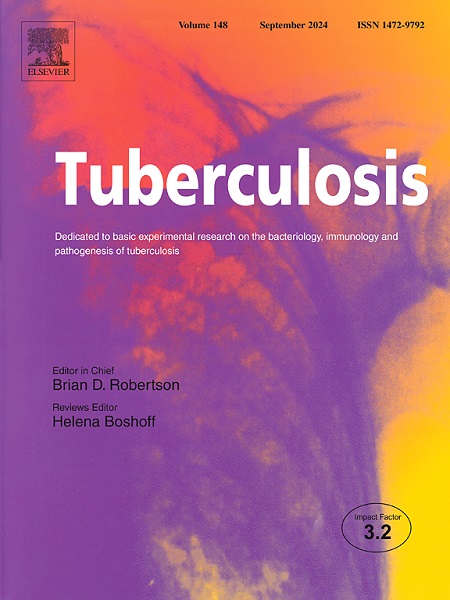Functional analysis of genetic mutations in ddn and fbiA linked to delamanid resistance in rifampicin-resistant Mycobacterium tuberculosis
IF 2.9
3区 医学
Q3 IMMUNOLOGY
引用次数: 0
Abstract
The connection between genetic mutations linked to delamanid resistance and phenotypic resistance remains unclear. We assessed the phenotypic effects of delamanid-resistant mutations in the Mycobacterium tuberculosis H37Rv strain through gene disruption using homologous recombination and complementation tests. Delamanid resistance was assessed by determining the minimum inhibitory concentration (MIC) via the 7H9 microdilution method. Sanger sequencing identified mutations, and conservation of the mutated residues was predicted through multiple sequence alignments of orthologs. A total of 116 isolates with MIC ≥0.025 μg/mL were analyzed, among which mutations were identified in the ddn and fbiA genes. Isogenic strains were generated based on these mutations. The ddn or fbiA isogenic strains with Ala77Val, Gly81Ser, Asn25fs, and Leu104Phe in fbiA had MICs ≥0.8 μg/mL, indicating resistance. In contrast, the ddn isogenic strain with Pro12Ala had an MIC of 0.012 μg/mL, showing susceptibility, while Gly96Asp in fbiA had an MIC of 0.1 μg/mL, indicating resistance. All mutations, except for Pro12Ala, were conserved in the protein sequences of both FbiA and Ddn and their mycobacterial orthologs. The characterization of these mutations provides insights into the mechanisms of delamanid resistance, which may inform the development of optimized treatment strategies.
耐利福平结核分枝杆菌中与德拉曼耐药相关的ddn和fbiA基因突变的功能分析
与delamanid抗性相关的基因突变与表型抗性之间的联系尚不清楚。我们利用同源重组和互补试验对结核分枝杆菌H37Rv菌株进行基因破坏,评估了delamanid耐药突变的表型效应。通过7H9微量稀释法测定最小抑菌浓度(MIC)来评估Delamanid耐药性。Sanger测序鉴定突变,并通过多个同源物序列比对预测突变残基的保守性。共检测到MIC≥0.025 μg/mL的分离株116株,其中ddn和fbiA基因突变。基于这些突变产生了等基因菌株。fbiA中含有Ala77Val、Gly81Ser、Asn25fs和Leu104Phe的ddn或fbiA等基因菌株mic≥0.8 μg/mL,提示耐药。与此相反,含有Pro12Ala的ddn等基因菌株的MIC为0.012 μg/mL,表现为敏感性,而含有fbiA的Gly96Asp的MIC为0.1 μg/mL,表现为抗性。除Pro12Ala外,所有突变在FbiA和Ddn及其分枝杆菌同源物的蛋白序列中都是保守的。这些突变的特征提供了对delamanid耐药机制的深入了解,这可能为优化治疗策略的发展提供信息。
本文章由计算机程序翻译,如有差异,请以英文原文为准。
求助全文
约1分钟内获得全文
求助全文
来源期刊

Tuberculosis
医学-呼吸系统
CiteScore
4.60
自引率
3.10%
发文量
87
审稿时长
49 days
期刊介绍:
Tuberculosis is a speciality journal focusing on basic experimental research on tuberculosis, notably on bacteriological, immunological and pathogenesis aspects of the disease. The journal publishes original research and reviews on the host response and immunology of tuberculosis and the molecular biology, genetics and physiology of the organism, however discourages submissions with a meta-analytical focus (for example, articles based on searches of published articles in public electronic databases, especially where there is lack of evidence of the personal involvement of authors in the generation of such material). We do not publish Clinical Case-Studies.
Areas on which submissions are welcomed include:
-Clinical TrialsDiagnostics-
Antimicrobial resistance-
Immunology-
Leprosy-
Microbiology, including microbial physiology-
Molecular epidemiology-
Non-tuberculous Mycobacteria-
Pathogenesis-
Pathology-
Vaccine development.
This Journal does not accept case-reports.
The resurgence of interest in tuberculosis has accelerated the pace of relevant research and Tuberculosis has grown with it, as the only journal dedicated to experimental biomedical research in tuberculosis.
 求助内容:
求助内容: 应助结果提醒方式:
应助结果提醒方式:


